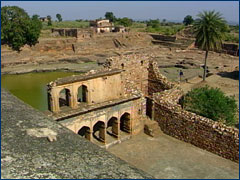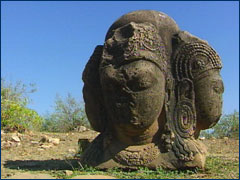|
|
Kalinjar
Situated at a distance of 280 km from Jhansi, this town and the fort,
which have had strategic important since the earliest of times, are
located in the ancient land of Jejakbhukti, which is an integral part of
Bundelkhand. The fort, a stronghold of the Chandelas from the 9th to the
15th century AD, remained an invincible citadel, prized for its location,
right until the time of the Mughals. During its eventful existence, the
fort was subject to numerous attacks by Mohammed Ghazni, Qutb-Ud-Din Aibak
and Humayun who invaded this stronghold of the Chandelas. It was Akbar who
finally conquered it in 1569 and bequeathed it as a gift to Birbal, one of
the "nine jewels" of his court. From Birbal, it went to Chhatrasal, the
legendary Bundela warrior and then to Hardev Shah of Panna. In 1812 it
fell into the hands of the British. This fort with its romantic and
extraordinary history is well worth a visit. The township of Kalinjar was
also once enclosed within a high rampart wall with four gateways, only,
three of which exist today. These are popularly known as the Kamta Dwar,
Panna Dwar and Rewa Dwar .

History
There are many legends about this fort. One of them ascribes the fort of
Kalinjar to the son of king Bharata from whom India took its ancient name
i.e., Bharat. The other claims it to be the aboard of Lord Shiva-Kal means
death and Jar means decay: thus the name exalts the god of destruction.But
Kalinjar is inextricably linked to the fortunes of the Chandella Kings of
Jijhoti or Bundelkhand. The history of Kalinjar moves in half-light till
the second half of the 10th century. In 1182 the Chandella forces were
defeated by the Hindu Chauhan Emperor. In1203Kalinjar fell to the Muslim
hosts of Qutub-ud-din Aibak.It was taken back by the Hindus after
defeating Afghan King Sher shah Suri in 1545. Mughal Emperor Akbar
captured the fort of Kalinjar in 1569 . It remained a part of the Panna
state untill surrendered to the British in 1812. The journey up the fort
is very straineous and hard and very few courageous can climb and explore
the wonders of the fort. The journey downward is also very precarious
Kalinjar means ‘the destroyer of time’ in Sanskrit. Kal is time and jar
destruction. It is therefore a common belief associated with the Kalinjar
hill that Lord Shiva had slain time on it. Since then the hill has been
considered to be holy site casting its shadow across the patches of
grasslands as well as the thickly forested valley. The natural splendour
of the surroundings make it an ideal place for penance and meditation and,
surprisingly, a strange mystique still pervades al over the hill. The
scriptures state that the holy place had four different names in the four
yugas. In satyuga it was known as Kirtinagar, in treta it was Madhyagarh,
in dwapar it was Singhalgarh and now in kalyuga it has come to be known as
Kalinjar. The hilly peak has several mythological legends attached to it.
The origin being shrouded in mystery, not much is known as to when and by
whom the fort was built on this holly hill though modern historians
conjecture that a Chandela king, Kedar Burman, had it erected in the 7th
century A.D. the fort was a unique monument of its time and had no
parallel in any other part of the country in terms of sheer grandeur and
artistry.
Its historical background is replete with numerous battle and invasions.
The Hindu princes of different dynasties as well as Muslim rulers fought
hard to conquer it and the fort continued to pass from one ruler to
another. But, except for the Chandelas, no other ruler could, however,
reign over it for a long time.
The fort was a Chandela stronghold from the 9th to the 15th centuries and
remained invincible up to the time of Mughals. Akbar finally conquered it
in 1569 and gifted it to Birbal, one of the "nine jewel" of his court.
From Birbal it went to the legendary Bundela warrior, Chhatrasal, and
thence to Hardev Shah of Panna.
In the year 1812 the British troops marched into Bundelkhand and after a
long drawn battle they were able to annex the fort. The British seizure
proved to be a great watershed, transferring the legacy of the old
aristocracy into the hands of the new bureaucracy of officials who showed
their loyalty to British imperialism. The damages caused to the fort can
still be perceived on its walls and open spaces.
WHAT
TO SEE
The majesty and grandeur witnessed within its precincts is due to the
Chandela rulers' creative imagination, their highly developed aesthetic
sense and religious fervor. Though they were great devotees of Lord Shiva,
they evinced a great interest in the construction of temples of other
deities, too. The massive rock cut sculptures include figures of various
gods and goddesses from ancient mythological themes. Wherever the
Chandelas had established their reign they left their mark by enriching
them with fine works of art, stone images, and sculpture.

The western part of the fort rewards all who take the time to look inside
the temple of Neelkanth Mahadev. Each time one peeps through a cave-like
opening and glances at an imposing Shivlinga of around five feet, one is
awe-struck. The idea has been to use landscape and cave-isolation to set
the solemnity of the mood for prayer. Its intrinsic feature is to reflect
and refract light in the appropriate seasons, letting in light in winter
and darkening to restrict its entry in summer.
Close to the Shivling cave, stand the idols of
Bhairava and goddess Parvati, made of black stone. On either side of the
gateway, images of numerous gods and goddesses are carved. A number of
broken pillars can also be seen at regular distances. On these pillars, it
is said, six-storey constructions were raised, but they were demolished
later. There are numerous rock-cut sculptures indicating neglect and
ravages of time. The vagaries of nature and of man have taken their toll
but the remnants indicate a synthesis of several ancient cultures and
faiths, the legacy of a glorious past.
Another beautiful sight is the palace of
prince Aman Singh. He was the descendant of King Chhatrasal. A number of
legends are associated with this Mahal whose big lawns and walls unfold a
long history of Chandela culture. Thousands of images made of granite and
sandstone have been collected in a museum set up informally. Rich carvings
on these images arrest the eye, even though they are broken and have been
struck by the ravages of time.
Trimurti images are also many, showing the faces of Brahma, Vishnu and
Shiva. Some distance away is carved a massive figure of Vishnu lying in
the ocean of milk, enclosed within the coils of the Sheshnag. It presents
a unique artistic charm. The presence of images of Lord Mahavira, the god
of love Kamadev, Indrani the wife of Indra etc. speaks of influence from
diverse cultures and religions. It also leads us to believe that the
creation of the Chandela culture was not the handiwork of artists from one
region.
The Chandela princes were influenced by the 'Shaiva'
cult. Therefore, among the rock-cut and stone images are mostly those of
Shiva, Parvati, Nandi and the Shivling. Shiva is seen at times in his
dancing posture of tandava and at others in a close embrace with goddess
Parvati.
There are numerous other attractions. The Venkat Bihari temple presents a
majestic look from the outside though its interiors are decayed now.
Persons suffering from skin diseases can take a dip in the 'pond of
million tirthas'.
The Sita-kund, Pandu-kund, Patal-ganga etc. speak for the Chandelas' taste
for the aquatic resorts.A reservior known as Patal Ganga; Pand-Kund, where
water trickels from the horizontal crevices of stratified rocks.
Budha-Budhi taal, whose waters are believed to possess healing qualities.
Sita Sej, a small cave containing a stone bed and pillow once used by
hermits. Bhairon-ki-jharia or Manduk Bhairon; the Mrigdhara or Antelope’s
spring situated within an inner chamber of the rampart.
Cemented roads have been built all through the mountainous passage, along
which people can conveniently travel to reach the fort. But to discover
the real charm and pleasure of adventure, one has to walk along the old
beaten track, making way through the rough and rocky terrain of the seven
magnificent gates falling in between. Seeing these gates, one truly
appreciates the functional relevance of this invincible fort and its
strategic defenses.
HOW TO REACH
BY AIR - The nearest airport is at Khajuraho, which is 130 km away.
BY RAIL - The nearest railway station is Atarra 36 km away, on the Banda-Satna
route, 57 km from the Banda railway station.
BY ROAD - The Kalinjar fort is linked by road to all the important centres
in the region with regular bus services. Some of the major road distances
are - Chitrakoot-78 km, Banda-62 km, Khajuraho-130 km, and Allahabad-205
km. |